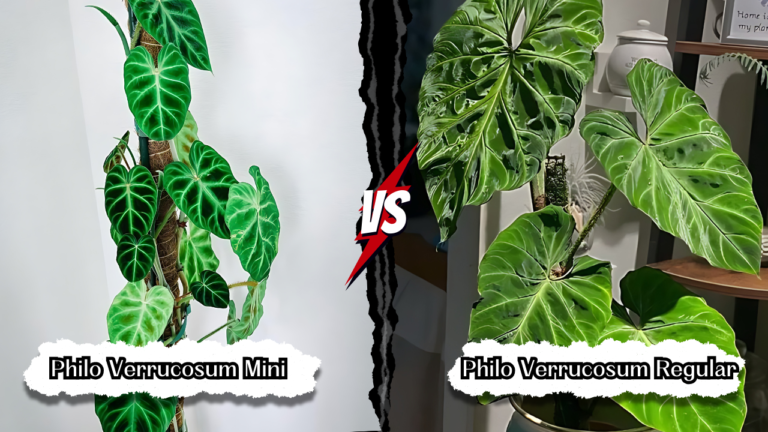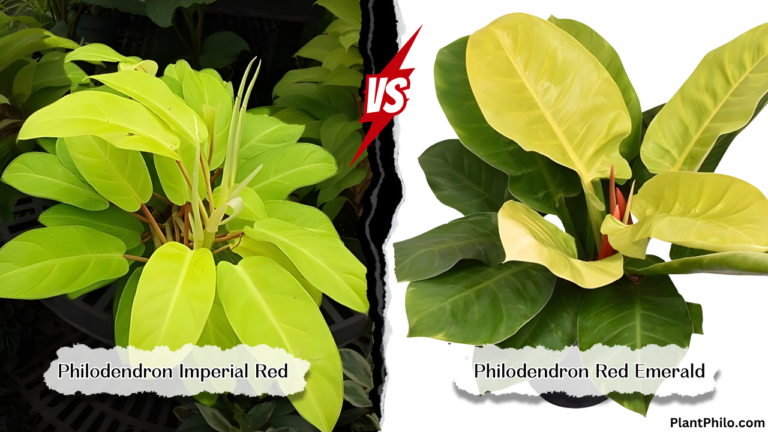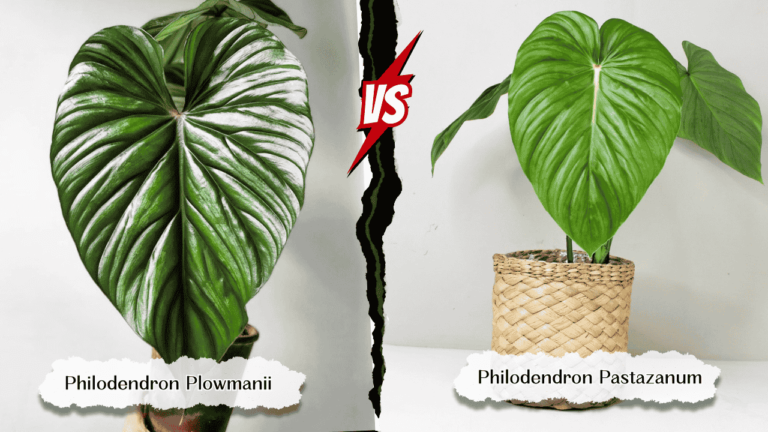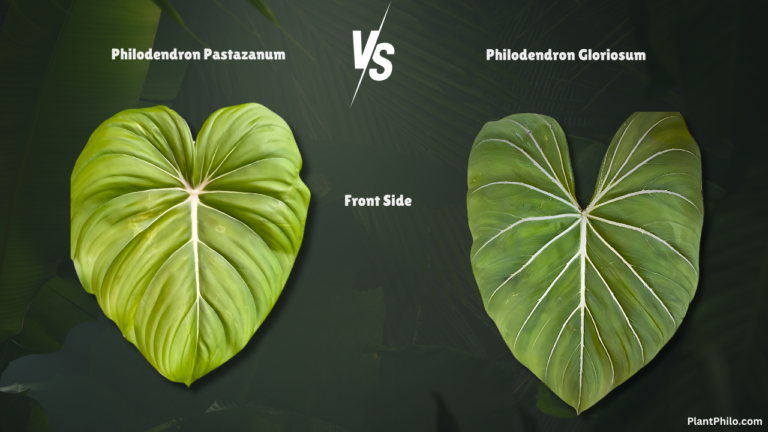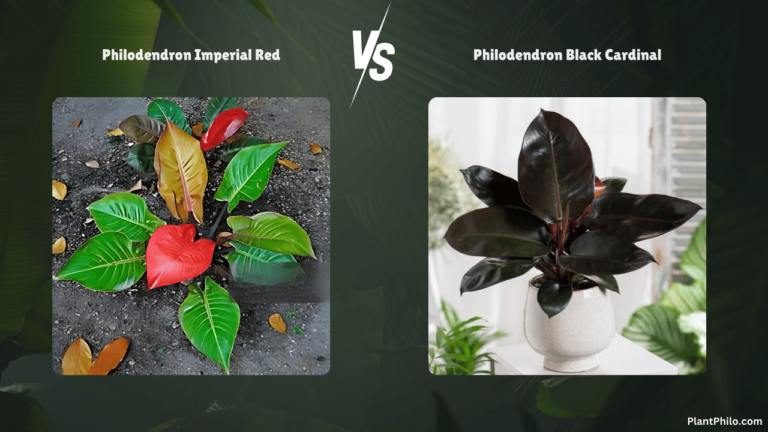Philodendron Atabapoense vs. Spiritus Sancti: Leaf Detective & Care
Can you spot the difference between a $50 Philodendron and a $5,000 one? These two look-alike species have fooled even expert plant collectors. Put on your Sherlock Holmes hat and grab your magnifying glass. We’re about to dissect the finer details of leaf shape, color, and growth habit that separate these two elusive Philodendrons. This article compares these unique Philodendrons to help you identify and differentiate them.
Philodendron Atabapoense and Philodendron Spiritus Sancti come from different parts of South America and have distinct characteristics. Philodendron Atabapoense, from Venezuela, has elongated, narrow leaves and a vining growth habit. On the other hand, Spiritus Sancti, native to Espírito Santo, Brazil, is extremely rare and known for its slightly wider and often larger leaves.
These plants also have unique care requirements. Both species thrive in high humidity and bright, indirect light, but there are subtle differences in their growth habits and structure. Knowing these differences can help you choose the right plant for your collection and ensure you provide the best care.
Key Takeaways
- Philodendron Atabapoense has smaller, narrower leaves compared to Spiritus Sancti.
- Philodendron Spiritus Sancti is extremely rare and more expensive than Atabapoense.
- Both species require high humidity and bright, indirect light to thrive.
Background and Origins
Philodendron Atabapoense and Philodendron Spiritus Sancti are two popular and rare tropical plants. They both originate from South America and grow in warm, humid climates, but they come from different regions with distinctive environmental conditions.
| Feature | Philodendron Atabapoense | Philodendron Spiritus Sancti |
| Origins | South America (Venezuela) | Brazil (Espírito Santo) |
| Rarity | Relatively Common | Extremely Rare |
| Price | Lower | Significantly Higher |
| Growth Habit | Vining, compact | Vining, potentially more vigorous |
| Leaf Shape | Narrow, lanceolate | Slightly wider, longer drip tip |
| Leaf Size | 6-12 inches | 12+ inches |
| Leaf Texture | Semi-glossy, smooth | Semi-glossy, smooth |
| Leaf Color | Deep green, sometimes bluish | Deep green, can have reddish/coppery new leaves |
| Veins | Less prominent | Slightly more prominent |
| Petioles | Shorter, thinner | Longer, thicker |
| Juvenile Form | Very similar to Spiritus Sancti | Very similar to Atabapoense |
| Definitive ID | Genetic testing | Genetic testing |
Additional Notes:
- The key visual differences between these two species are often subtle and most noticeable in mature specimens.
- Juvenile plants can be nearly indistinguishable, making genetic testing the most reliable way to confirm the species.
- Both plants require similar care, with a preference for high humidity and well-draining soil.
- Due to the extreme rarity of Spiritus Sancti, it’s important to be cautious of mislabeled plants and prioritize reputable sources when purchasing.
Philodendron Atabapoense
Philodendron Atabapoense is a vining plant native to South America, specifically from the region near the Atabapo River in Venezuela. Its natural habitat includes rainforests with high humidity and warm temperatures. This species is a climber, using trees and other structures for support as it grows upwards.
The leaves of the Philodendron Atabapoense are elongated and narrow, often reaching about 8-10 inches in length. The plant is known for its striking foliage, which is deep green sometimes with a bluish tint. It thrives in conditions that mimic its natural environment, preferring indirect light and well-draining soil.
Philodendron Spiritus Sancti
Philodendron Spiritus Sancti is one of the rarest and most sought-after philodendrons. This plant is native to the state of Espírito Santo in Brazil. It is highly endangered, with only a few known specimens remaining in the wild. The natural habitat of this plant includes tropical rainforests that offer high humidity, warm temperatures, and ample shade.
The leaves of the Philodendron Spiritus Sancti are long and narrow, similar to Philodendron Atabapoense, but can grow up to 28 inches in length. The plant has a vining growth habit and requires structures to climb. The rarity of this plant makes it highly desirable among collectors and plant enthusiasts.
Both Philodendron Atabapoense and Philodendron Spiritus Sancti share similarities in their leaf shapes and environmental preferences, but their origin and scarcity set them apart.
Visual Comparison: Leaves
Understanding the visual differences between the leaves of Philodendron Atabapoense and Philodendron Spiritus Sancti is essential. These differences include the shape, size, texture, color, veins, and petioles.
Shape
Philodendron Atabapoense has narrow, lanceolate leaves. These leaves taper to a point, giving them a sleek, sword-like appearance. They are elongated and often appear very thin. In contrast, Philodendron Spiritus Sancti leaves are slightly wider.
The base of these leaves often appears more rounded, and the tips have a longer, more pronounced drip tip. This shape helps in differentiating it from the Atabapoense.
Size
The size of the leaves is a significant visual indicator. Philodendron Atabapoense usually has leaves ranging from 6-12 inches long. These leaves are relatively small compared to other species.
On the other hand, Philodendron Spiritus Sancti features larger leaves. These can exceed 12 inches, with some reaching up to 28 inches in length. The substantial difference in size can help you identify these plants correctly.
Texture
Both Philodendron Atabapoense and Philodendron Spiritus Sancti have a semi-glossy or satin-like texture on their leaves. This smooth texture makes them highly appealing. While there isn’t much difference in the texture between the two species, this satin-like finish is a key characteristic to be aware of when examining the leaves closely.
Color
Philodendron Atabapoense typically has deep green leaves. Sometimes, these leaves may exhibit a slight bluish tint. Philodendron Spiritus Sancti, while also having deep green leaves, can show more variation.
New leaves of Spiritus Sancti may present a reddish or coppery hue. This color variation is an important factor to consider when distinguishing between the two plants.
Veins
The vein patterns on the leaves offer another clue. Philodendron Atabapoense has less prominent veins. These veins usually blend into the leaf color and are not as noticeable. In comparison, Philodendron Spiritus Sancti has more prominent veins.
These veins can be slightly lighter in color, often appearing greenish-white. The distinct veins of Spiritus Sancti set it apart from Atabapoense.
Petioles (Leaf Stalks)
The petioles, or leaf stalks, also differ between the two species. Philodendron Atabapoense has round, smooth petioles that are typically shorter and thinner.
Philodendron Spiritus Sancti, while also having round and smooth petioles, tends to have longer and thicker ones. This distinction in the petiole size can help in identifying the species, especially in juvenile plants.
Growth Habit and Structure
Explore the key differences in growth habits and structures between Philodendron Atabapoense and Philodendron Spiritus Sancti. Both are climbing plants, but they have distinct characteristics that make each unique.
Philodendron Atabapoense
Philodendron Atabapoense has a vining growth habit, making it ideal for climbing up trellises or other support structures. The plant’s stems are relatively thin and produce aerial roots that help it cling to surfaces as it grows.
Despite its climbing nature, Atabapoense tends to maintain a more compact growth. The plant’s leaves are elongated and narrow, typically ranging from 8-10 inches long. This size difference means it can fit well in smaller indoor spaces or containers.
Atabapoense is relatively fast-growing and prefers bright, indirect light. Ensure the plant’s support system is sturdy to accommodate its climbing needs, as it’s essential for healthy growth. Yet, its bushier appearance makes it less sprawling, making it easier to maintain in comparison to larger varieties.
Philodendron Spiritus Sancti
Philodendron Spiritus Sancti is distinguished by its impressive size and robust growth patterns. This plant can grow up to 65 feet tall and 6 feet wide when provided with the right conditions. Like Atabapoense, Spiritus Sancti has a vining growth habit, but its stems and leaves are much larger.
The leaves of Spiritus Sancti can reach up to 28 inches in length, creating a striking visual impact. The plant also develops aerial roots, which support its climbing structure. With long internodes, the space between leaves can be considerable, contributing to its expansive spread.
Spiritus Sancti thrives in bright, indirect light and high humidity. Its growth habit requires substantial support, such as a sturdy trellis or a large pot for its aerial roots to grip. This plant’s grand scale and faster growth rate make it a dramatic centerpiece for any indoor garden.
Care Requirements
Proper care of Philodendron Atabapoense and Philodendron Spiritus Sancti involves managing light, water, humidity, temperature, soil, and pH levels to keep these rare plants thriving.
Light
Both plants prefer bright, indirect light. Direct sunlight can scorch their leaves, making it important to place them near a window where they receive plenty of light without direct exposure. If you have a spot with lower light levels, consider using a grow light to supplement. Avoid placing these plants in complete shade as this can hamper their growth.
Water
You should water your Philodendron Atabapoense and Spiritus Sancti regularly but avoid overwatering. Let the top inch of the soil dry out before watering again. Overwatering can lead to root rot, so ensure good drainage.
Use room temperature water to avoid shocking the plants. Consider reducing the frequency of watering in cooler seasons when growth slows down.
Humidity
High humidity is key for these philodendrons. Aim for humidity levels between 60-80%. In dry climates or during winter, use a humidifier or place the plants on a tray of water and pebbles to increase humidity. Regular misting can also help but avoid misting excessively as it can promote fungal issues.
Temperature
Maintain a temperature range between 65-85°F (18-29°C) for optimal growth. Avoid placing these plants in locations with cold drafts or sudden temperature changes. Both Philodendron Atabapoense and Spiritus Sancti can tolerate slightly cooler temperatures at night but should not be exposed to conditions below 60°F (15°C).
Soil
Choose a well-draining, airy potting mix for these plants. A mix designed for aroids or orchids works well. Adding perlite, bark, or charcoal can improve drainage and aeration, preventing waterlogged conditions that lead to root problems. Always use pots with drainage holes to ensure excess water can escape.
pH Level
The ideal pH level for these philodendrons is slightly acidic to neutral, around 5.5 to 7.0. You can test the soil pH with a simple test kit available at garden centers. If adjustments are necessary, using amendments like peat moss can lower the pH, while adding lime can raise it.
Adhering to these care guidelines will help you maintain healthy and vibrant Philodendron Atabapoense and Spiritus Sancti plants. For more specific tips, visit Philodendron Atabapoense Care and Philodendron Spiritus-Sancti guides.
Additional Differentiating Factors
Several key factors distinguish Philodendron Atabapoense from Spiritus Sancti. These include rarity and price, differences between juvenile and mature forms, and the role of genetic testing.
Rarity and Price
Philodendron Spiritus Sancti is one of the rarest and most sought-after plants in the world. Native to Espírito Santo, Brazil, it is extremely hard to find, which drives up its price significantly. Collectors might pay thousands of dollars for a single specimen.
In contrast, Philodendron Atabapoense, while still considered a rare plant, is more commonly available and affordable. It hails from South America, primarily Venezuela, and does not command the same high prices as the Spiritus Sancti.
Juvenile vs. Mature Forms
Distinguishing between juvenile and mature forms of these plants can be tricky. Juvenile forms of both species often look quite similar, with narrow, lanceolate leaves. As they mature, Atabapoense develops more sword-like, elongated leaves with a deep burgundy underside.
Spiritus Sancti, on the other hand, grows larger leaves that can reach up to 28 inches and may exhibit a more pronounced drip tip. Understanding these differences is crucial for collectors who want to correctly identify their plants as they grow.
Genetic Testing
The most definitive method to confirm the species of a Philodendron is through genetic testing. This process can identify subtle genetic markers that distinguish Spiritus Sancti from Atabapoense.
Genetic testing can be especially useful for serious collectors who want to ensure they are not misidentifying their plants, especially when dealing with juvenile forms that look similar. Although genetic testing can be costly and requires specialized knowledge, it offers the highest accuracy in identification.
Responsible Collecting and Conservation
Collecting rare plants like Philodendron Atabapoense and Spiritus Sancti has become increasingly popular. However, with this popularity comes the responsibility of ensuring ethical sourcing and conservation efforts.
Conservation Status
- Philodendron Atabapoense: Not currently listed as endangered.
- Philodendron Spiritus Sancti: Critically endangered due to habitat loss in Brazil’s Espírito Santo region.
Ethical Sourcing
- Buy from reputable nurseries that propagate plants responsibly.
- Avoid purchasing wild-collected specimens to protect natural populations.
- Look for certifications or statements indicating the source follows ethical practices.
Habitat Loss
- Rainforests are being cleared for agriculture and urban development.
- Supporting companies that engage in sustainable practices helps reduce habitat destruction.
Trade and Endangerment
- The demand for rare plants like Spiritus Sancti can lead to illegal trade.
- Be wary of sellers who cannot provide cultivation or ethical sourcing information.
Tips for Responsible Collecting
- Research: Understand the origin and conservation status of the plant.
- Verify: Check if the seller adheres to ethical and sustainable practices.
- Support: Choose to buy from vendors who contribute to conservation efforts.
- Propagate: Consider growing your plants from seeds or cuttings to reduce the demand for wild specimens.
Frequently Asked Questions
This section answers common questions about the differences, care requirements, market availability, and hybrid varieties of Philodendron Atabapoense and Philodendron Spiritus Sancti.
How does the growth habit of Philodendron Atabapoense differ from that of Philodendron Spiritus Sancti?
Philodendron Atabapoense has a more compact and bushy growth habit. It tends to be shorter and less aggressive in climbing compared to Philodendron Spiritus Sancti. On the other hand, Philodendron Spiritus Sancti grows more vigorously with longer internodes, making it taller and better suited for climbing.
What are the defining characteristics that distinguish Philodendron Spiritus Sancti from Philodendron Atabapoense?
Philodendron Spiritus Sancti has larger leaves, often reaching up to 28 inches in length, compared to the 8-10 inch leaves of Philodendron Atabapoense. The leaves of Spiritus Sancti are slightly wider and may have a reddish or coppery hue on new growth, while Atabapoense leaves are narrower and deep green with a bluish tint. Additionally, Spiritus Sancti’s petioles are generally longer and thicker.
Can you compare the care requirements for Philodendron Atabapoense and Philodendron Spiritus Sancti?
Both Philodendrons thrive in bright, indirect light and well-draining, airy potting mix. They require high humidity levels (60-80%) and temperatures between 65-85°F (18-29°C). It’s essential to allow the top inch of soil to dry out between waterings to prevent root rot. The care requirements for both plants are quite similar.
Are there notable differences in the rarity and market availability of Philodendron Atabapoense versus Philodendron Spiritus Sancti?
Philodendron Spiritus Sancti is extremely rare and much more expensive compared to Philodendron Atabapoense. It is native to a very limited range in Espírito Santo, Brazil, which contributes to its scarcity. In contrast, Philodendron Atabapoense is more accessible and affordable for collectors and enthusiasts.
What potential hybrid varieties exist between Philodendron Atabapoense and Philodendron Spiritus Sancti, and how do they compare?
There are no widely known hybrid varieties between Philodendron Atabapoense and Philodendron Spiritus Sancti. If hybrids do exist, they would likely require very specific conditions to thrive. Their characteristics would likely be a mix of the parent plants, but more research and experimentation would be needed to establish any common traits.
In terms of investment, how do the values of Philodendron Atabapoense and Philodendron Spiritus Sancti compare?
Philodendron Spiritus Sancti is a significant investment due to its rarity and high market demand, often fetching prices in the thousands. In contrast, Philodendron Atabapoense is more affordable, making it a less costly but still rewarding addition to your plant collection. If you’re looking at these plants as an investment, Spiritus Sancti’s value is much higher.

